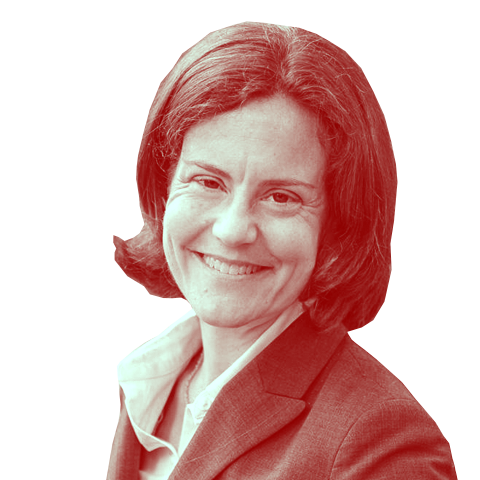Are Swiss banks’ glass ceilings for women ready for a real shattering?

As one of the world’s most conservative financial preserves, Switzerland’s clannish private banks have in recent years had to adapt to a changing world. Globalisation and a push for greater transparency is putting its historic hub into rebranding mode, while its top management has ever so slowly begun cracking the door open to a “new” type of talent: women.
As Swiss banks transition away from banking secrecy and become more global, all the while claiming Switzerland as a hub for sustainable finance, the notion of a gender balance often still remains a nebulous concept in the sector.
In spite of gender quotas within boards of directors and executive boards becoming part of Swiss law in 2021 – requiring at least 30% of the former and 20% of the latter be held by women – the corporate landscape in the country remains far behind its neighbours on female representation. A recent studyExternal link that looked at the proportion of women in leading roles in European listed companies put Switzerland near the bottom of rankings, and none of the 20 companies listed on the Swiss Market Index has a woman CEO.
The minimum quotas were not designed as binding obligations and no sanctions are planned in case of failure to comply.
When a communications officer at a mid-sized Geneva private bank was recently asked in a phone interview about gender diversity, he began explaining different types of diversified investment strategies. He had to be reminded by this journalist that the questions were rather about equitable representation of both sexes.
“A very conservative company culture attracts that type of conservative-thinking talent,” said Anina Cristina Hille, a diversity expert at the Lucerne University of Applied Sciences and Arts, explaining why some companies fail to bring women into their managerial fold.

More
To advance gender equality in Switzerland, remove family status from CVs
At 11 Geneva private banks, where partner positions have long been held by male members of a small number of founding families, only 10% of top mandatesExternal link – including partners, administrators or members of general management – are held by women, according to financial news agency AWP. No international comparison exists with similar banks in other financial hubs such as London or Luxembourg.
Banks Bordier and GonetExternal link for instance, lack a single woman in director or senior management roles. Neither of the banks accepted to respond to questions from SWI swissinfo.ch. Marcos Esteve, CEO at HeritageExternal link, which also has an all-male executive management team, told SWI in an email that the firm takes the concern over diversity “seriously.”
“We are on it,” he added.
Old mindset
Many limitations and hurdles for women still exist in the industry as a whole including mindsets and a working environment where women feel out of place.
“There’s this history of private banking families run by the men, where the partnerships were passed on to the sons and grandsons,” said Nathalie Fontanet, Geneva cantonal government’s finance chief. “But we need to work on the role of the woman, on the confidence that’s there, and that she can position herself in the same way [as men] within the families to take over those roles.”
Fontanet, who had worked in finance before entering politics, has long campaigned for a gender parity lawExternal link for boards of directors in public companies and foundations.
Christèle Hiss Holliger, global head of human resources at Pictet, said the process of improving gender diversity at the Swiss private banks “takes time and conviction”. She said in 2016, when she became the bank’s first female equity partner – part of a group of over 40 senior executives – she was encouraged by the promotion and hoped it would lead to impact on the issue.
Simone Stebler, a financial services consultant at recruitment firm Egon Zehnder, said that aside from the high cost of childcare in Switzerland, an old mindset of women being the first caregivers was “holding women back”. She added that there was a lack of flexibility towards fulltime employment, particularly for senior roles.

More
Gender inequalities remain when balancing work and family life
“That mindset needs to shift,” she said, adding that women would often limit themselves to middle- or back-office positions in banks. “There seems to be a hesitancy among women when it comes to front responsibility, where you need to spend time with clients and dinners out. There are doubts about ‘Will I be able to acquire enough clients, can I and do I want to do this?’”
Having policies in place that would attract women to the sector, and support them, would help when it comes to enhancing gender diversity, she added. “You really need to tackle this issue holistically, because there is no quick fix.”
Change on the way?
Some banks though have begun to see movement.
In 2021 Elif Aktug became the first female managing partner at Pictet, estimated to be the fourth-biggest Swiss wealth management bank. Aktug, who was promoted after leading the bank’s €2.5 billion (CHF2.6 billion) European equity strategy, recently spoke at a gender panel at the Building Bridges conference organised by the banking sector, the United Nations and other international groups to promote sustainable finance.
She said that as a co-founder of the Pictet Women’s Network group, she found it very important “to bring into the conversation” an understanding of women’s work experience in order to progress. Only a handful of men attended the session, a sad reflection as participants noted how discussions on gender representation failed to attract sufficient attention from male movers and shakers.

More
Gender pay gap widens in Swiss banking sector
When asked by SWI swissinfo.ch when she thought the next woman would join as a partner in the bank, Aktug smiled and answered: “I hope in less than 216 years!” The bank, founded in 1805, has been run by a total of only 45 partners, including the current eight.
Hiss Holliger said Pictet had introduced mentoring, employee resource group discussions over diversity and inclusion, parenthood support and flexible work schedules.
In 2021, she said, the bank hired an all-time high proportion of women, some 45% of all positions, without specifying the numbers in top management. “We have considered positive discrimination because we really want to achieve more diversity… and are constantly challenging why we don’t have women on shortlists of candidates. That also applies to internal mobility. All our partners are extremely vocal on this.”
Elsewhere in Geneva, other private banks are opening their doors – albeit slowly – to women. Since 2017 Lombard Odier has one female partner, Annika Falkengren; she joined five men at that level. At Mirabaud, another one of the old institutions, Camille Vial is one of the bank’s four managing partners. She was nominated in 2012.
More than window dressing
The drive for change has also been attributed to clients pressuring banks for more diversity, while researchExternal link has shown that better gender representation leads to better innovation and improved financial performance.
Experts have nonetheless argued that, like in other sectors, finance has not been immune from female window-dressing.
Neil Tredennick, founding partner and banking specialist at Lotus Partners in Geneva, noted a “very strong trend” among private banks to find female candidates. He said he receives requests either for an exclusively female pool of candidates for a role, or specifically that the pool include women.
“The banks clearly have goals that they have to achieve in terms of increasing female-held positions, and in some cases that could mean increasing those recruitments by 40%,” he said.
But participants at the Building Bridges panel argued that it was important as the Swiss financial sector promotes itself as a hub for sustainable investment, that the gender lens be genuine not only in hiring patterns, but also in investment advice that values gender diversity.
In the meantime, recruiters warned banks of the war on talent. “Diversity is a reality, but inclusion is a choice,” Stebler at Egon Zehnder said.
For those who have been slow to adapt to that reality, the cost may be high. “Banks need to provide employees, both men and women, with what they are asking, otherwise you risk losing personnel,” Tredinnick said. “We are going to end up with a shortage of personnel, a shortage of qualified candidates, and salary inflation.”
(Edited by Virginie Mangin)

More
Call to tap potential of professional working women

In compliance with the JTI standards
More: SWI swissinfo.ch certified by the Journalism Trust Initiative


You can find an overview of ongoing debates with our journalists here. Please join us!
If you want to start a conversation about a topic raised in this article or want to report factual errors, email us at english@swissinfo.ch.